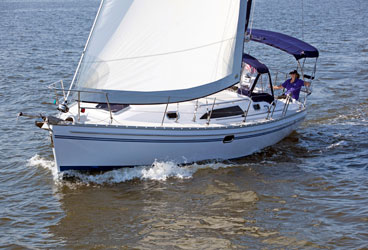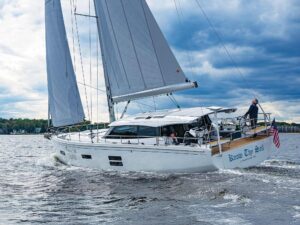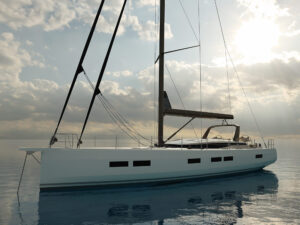
BOTY Winners Lead
Fresh ideas, innovative solutions, and, in one case, brand-new boathandling technology that could prove to be a real game-changer awaited the 2011 Boat of the Year judges as they went to work at the U.S. Sailboat Show in Annapolis, Maryland, over the long Columbus Day weekend. But I had a feeling that’d be the case, based on Cruising World’s preview of this year’s new models (see “New-Boat Preview 2011,” October 2010) and on what I’d seen at shows and during test sails earlier in the year.
After a couple of rough-and-tumble years for the new-boat marketplace, it was readily apparent this past fall that boatbuilders and designers have embraced the idea that coming up with new—really new—models that are sexier, faster, more comfortable, easier to sail, and more maneuverable under power is more important than ever. And you know who benefits from this? We do. I’ve been covering new boats for a long time now, and I honestly can’t remember a fleet of new designs that as a class was more intriguing.
From an all-carbon speed machine to comfortable cruisers to a couple of boats that create niches all to themselves, this year’s BOTY lineup included enough diversity to keep the judges on their toes. The 2011 categories came together as CW editors made preliminary reviews of potential nominees at the Newport International Boat Show and in the days leading up to the show in Annapolis. Then we brought in our team of outside experts for the dockside inspections during the show itself and for sea trials on Chesapeake Bay the following week.
Overall, the number of new sailboats being introduced in North America is down from the boom years of earlier in the decade, but still, this year, 19 models met CW’s criteria to become BOTY nominees. As they have in past years, BOTY judges assessed each boat according to its design brief, and after lengthy discussions each evening after sea trials, they picked those that most closely hit the mark. Read on to learn about all of the 2011 BOTY nominees and to discover what it took to emerge as a winner.
Small Cruisers, 30 Feet and Under
Diversity and innovation were evident in almost every category, but the Small Cruiser grouping may have been the most interesting. That’s because it was comprised of three very different boats that accomplished their stated design briefs in very different ways.
The Hunter 27E is a pocket cruiser that has the arch-mounted mainsail traveler, stern seats, backstay-less B&R rig, and maximized accommodations that you’d expect to find on a Hunter—and an electric motor that you probably wouldn’t. The Elco Motor Yachts power plant isn’t a hybrid. It’s simply an electric motor that’s powered by batteries that must be charged either by hooking the boat up to shore power or by optional solar-power and wind-power generators that can be mounted on the boat’s stainless-steel bimini frame. During the judges’ test, the motor had enough power to push boat speed up to nearly 6 knots. The engine’s control panel is even fitted with a “Power Boost” button that’ll generate a bit more speed in short bursts. As with all electric propulsion systems, range under power depends on battery capacity and motoring speeds. The motor and battery setup the judges tested had about 6 hours of normal-use run time.
Up against the Hunter was the category-defying Presto 30, a shoal-draft 30-footer with two carbon-fiber masts; wishbone rigs; square-topped sails; a cozy, camper-type interior with minimal headroom; and a retractable outboard motor that’s mounted in a trunk in the forward part of the cockpit. During lengthy deliberations, the judges agreed that the boat was outside of the parameters of an average cruising sailboat, but they noted that it’s critical to reward innovative boats that stretch the envelope in some unique way. As a result, they created a special recognition for the Presto, giving it the Cruising Spirit Award. The Presto, they said, is not only well built and fun to sail but also could attract a whole new group of sailors by expanding the boundaries of what a cruising boat can be.
The category winner, the Beneteau First 30, is a sporty little rocket designed by raceboat designer Juan Kouyoumdjian. The judges warmed to the boat’s creature comforts at the dock, then fell head-over-heels with the way the boat sailed when each took the helm out on the bay. As a result, the Beneteau First 30 was named the Best Small Cruiser, 30 Feet and Under.
Click here for the full write-up on the Presto 30.
Click here for the full write-up of the Beneteau First 30.
Midsize Cruisers, 30 to 39 Feet
While the Small Cruisers were interesting because the boats were so different, the Midsize Cruisers show that some builders are going after buyers by paying attention to sensible boats less than 40 feet in length that have the capability to take an owner off voyaging, if that’s the desire.
The German-built Hanse 375 got rave reviews for the way it sailed. The judges remarked on the sweet feel of the helm and how easy the boat was to singlehand, with its well-designed self-tacking jib. They also liked the overall cockpit and deck layout.
The Dufour 375 Grand’ Large, built in France, also has the Euro-sexy lines of the Hanse, and its sailing performance garnered good comments from the judges. During their deliberations, the judges noted that the amply sized double bunk to port, instead of a typical V-berth that forces two people to play footsie in the bunk, is a great way to maximize the comfort and space in the forward cabin on a boat under 40 feet.
As for the boats that were built on this side of the prime meridian, the judges tested the “Performance Version” of the Hunter e36 (the “e” in this case stands for “extended”), and they felt that the boat’s square-topped laminated main and roller-furling jib gave the boat a bit more get-up-and-go than standard Dacron sails would have, especially in the light air they experienced during their test sail.
However, what really caught the judges’ attention was the rock-solid construction and execution of ideas that resulted in the Catalina 355. They felt that the accommodations plan struck the elusive balance between being comfortable at the dock and seaworthy while under way. And they liked how the boat performed under sail. As a result of all these good things, plus a few others, the judges named the Catalina 355 the Best Midsize Cruiser, 30 to 39 Feet, as well as the Domestic Boat of the Year.
Click here for the full write-up of the Catalina 355.
Cruisers, 40 to 49 Feet
On the surface, the three boats in the 40-foot range that were tested have a lot in common. They’re all stylish, performance-oriented cruisers. And they’re all built in France. But as the judges dug into the details, both at the dock and on the water, each distinguished itself in its own way.
The Jeanneau Sun Odyssey 409 is a new design from Philippe Briand. The hull features a hard chine aft that gives the boat a sharper, more modern look while also providing slightly more interior volume in the aft cabin; the chine should also help increase overall stability a bit. On deck, the judges found the cockpit layout and sight lines from the dual helms over the low coachroof to be excellent, and down below, they liked the flow of the contemporary interior.
Meanwhile, Dufour Yachts entered two boats in this category. The Dufour 405 Grand’ Large has the requisite dual helms, bulb keel, powerful sail plan, and rakish good looks that you’d expect from a Euro performance/cruiser. But it was the details—such as the boat’s superior anchor-handling system and the adjustable chart-plotter mount that makes the screen easily visible from either helm—that had the judges scribbling in their notebooks.
Having three somewhat similar boats in this competitive category made for some tough decisions. But as the deliberations wore on, and the judges started discussing the Dufour 45e, comments like “The helm feel was excellent” and “This is one of the best boats we’ve sailed yet” got lots of nods of agreement. As a result of its outstanding sailing performance and other positive qualities, the Dufour 45e was named the Best Cruiser, 40 to 49 feet.
Click here for the full write-up of the Dufour 45e.
Full-Size Cruisers, 50 to 55 Feet
Each boat in this category steered a very different route in defining what a 50-foot cruising boat can be. As a result, the judges had a tough decision to make when it came time to pick a winner.
The Moorings 50.5 is a Beneteau 50 that’s been built specifically for The Moorings and its charterers/owners, who are looking to defray costs by putting the boat into the company’s charter fleet during the first five years of ownership. As a result, the boat is designed to stand up to the rigors of being in service 20 to 25 weeks per year during that time. Sure, there aren’t many options (the boats are standardized for the fleet with four cabins, four heads, etc.), but the judges all agreed that the 50.5 is comfortable, sails well, could be fun to own when it’s in charter, and, as long as the maintenance schedule is maintained, could be a great cruising boat when it comes out of The Moorings fleet.
The Jeanneau 53 takes a different tack. It’s designed to be a bluewater passagemaker and to provide all the luxury of a “yacht” without the seven-figure price tag of some custom-built boats in this size range. Under way, the judges found the sails to be easy to trim and the boat quite maneuverable. Down below, they found the interior could make for a comfortable home, both on an extended passage or at the dock.
But when it came time to choose a winner, it was the Beneteau Sense 50 that turned circles around the competition—literally. It’s equipped with Groupe Beneteau’s Dock & Go system—a joystick controls both the bow thruster, the engine throttle, and the rotating saildrive unit—that may just revolutionize close-quarters maneuvering under power. That, along with an innovative cockpit and interior layout that’s unlike any other 50-foot monohull, made for a boat that was chock full of fresh ideas. More important, the judges found that the innovations they saw were way more than just gimmicks and it was named the Best Full-Size Cruiser, 50 to 55 Feet.
Click here for the full write-up of the Beneteau Sense 50.
Premium Cruisers Over 55 Feet
It was tough to narrow down the boats in this category, simply because they all have the systems, displacement, waterline length, and interior volume to be luxurious, speedy, and seakindly passagemakers. But as it turns out, each also had qualities to make it unique.
The Beneteau Oceanis 58 is all about space. On deck, the cockpit features dual wheels, long, comfortable seats, a huge swim platform, and excellent stowage. For blue water, the judges would’ve liked to have seen taller lifeline stanchions and more handholds forward of the mast, but on the other hand, they were particularly impressed with the companionway. It features a larger-than-average opening and the best “stairs”—not a companionway ladder but wide, shallow-sloped steps with excellent handholds—of all the boats they tested.
By way of contrast, the Southerly 57RS is all about the freedom that comes from the ability to reduce draft from well over 10 feet to under 4 feet simply by pushing a button that hydraulically raises the 7,275-pound swing keel. The judges found that the space required to accommodate the keel trunk and the lifting mechanism necessarily required some design compromises in the interior, but they also felt that the boat’s raised saloon, which affords sailors a good view out of the wraparound ports while seated at the table, made the most of the available space.
Still, after inspecting and sailing the Hylas 56—one of the more conventional boats in the whole BOTY fleet—the judges concluded that in the case of this model, “If it ain’t broke, make it better” was exactly the right thing to do. The judges liked the boat’s sturdy construction and felt that everything, from the robust winches to the ground tackle to the storage lockers, addressed the needs of serious cruisers. The overall fit and finish of the hull and interior, along with the high quality of the systems, reflected an attention to detail that they felt should be commended. As a result, the judges named the Hylas 56 as the Best Premium Cruiser Over 55 Feet.
Click here for the full write-up of the Hylas 56.
The Catamarans
Three very different cruising catamarans vied for top honors in this category. On the Matrix Vision 450, the judges were impressed with the overall flow of the accommodations plan and with the main stateroom, which occupied the entire port hull in the three-cabin version they tested. Under sail, they thought that some aspects of the deck layout could be refined, but they agreed that the boat performed well in the 12 knots of breeze they had during their test.
Meanwhile, no boat at the show drew as many gawkers as the all-carbon Gunboat 66. Even in the moderate breeze the judges experienced during the sailing portion of their evaluation, they were awed by the boat’s passagemaking potential. The judges agreed that it’s a marvel of engineering. And they concurred that anyone with a need for drag-racer speed—who could also afford a price tag that’s north of US$4 million and, in most cases, a professional crew—would die to own the Gunboat.
But which of these catamarans would be best suited to a couple cruising around the world? When our experts were searching for their answer to this question, they found they kept coming back to the Discovery 50. They praised the boat’s sturdy construction, redundant systems, and overall quality craftsmanship. They also found the master cabin that runs the full width of the boat forward of the mast to be the best out of all the boats they tested, and the guest cabins, aft in each hull, came out at the top of the list as well. So it was a long list of “likes” and “loves” that led our BOTY team to name the Discovery 50 as the Best Catamaran and also to deem it to be the Import Boat of the Year.
Click here for the full write-up of the Discovery 50.
There you have it. This year’s fleet of new boats shows that good things can come from trying times. Sailboat builders had to innovate to excite current owners and to attract new ones, and in many cases they did. As a fleet, this year’s new boats represent a quantum leap forward when compared with what’s been built before and consequently available on the used-boat market. If a new boat’s in your future, this year’s class, introduced in Annapolis, brings a lot of fresh ideas to the table.
Bill Springer is CW__’s senior editor and its Boat of the Year director.








